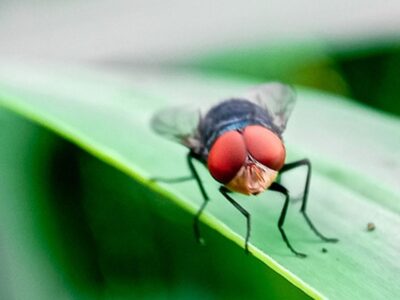



USDA announces "major investment" to protect US from New World Screwworm
USDA will construct a $8.5 million sterile fly production facility at Moore Air Force Base in Texas; substantial completion is expected at end of 2025US Secretary of Agriculture Brooke L. Rollins today at the Texas State Capitol alongside Governor Greg Abbott and stakeholders from across the country announced the largest initiative yet in the US Department of Agriculture’s (USDA) plan to combat the New World Screwworm (NWS). This announcement builds upon USDA’s five-pronged plan issued in June to combat the northward spread of NWS from Mexico into the United States.
As part of this comprehensive approach, USDA is taking the following immediate actions:
1.) Innovate Our Way to Eradication
While sterile flies are currently the most effective way to prevent the spread of NWS, technology continues to evolve and as such USDA will provide up to $100 million to invest in viable innovations which could show rapid advancement of promising technologies that will augment the United States facility and accelerate the pace of sterile fly production if proven successful. USDA will support proven concepts that only require funding to scale and implement as well as a number of longer-term research projects focused on: new sterile NWS production techniques, novel NWS traps and lures, NWS therapeutics that could be stockpiled and used should NWS reach the United States, and any other tools to bolster preparedness or response to NWS.
2.) Protect the United States Border – Construction of a Domestic Sterile Screwworm Production Facility

USDA will construct a sterile fly production facility in Edinburg, TX, at Moore Air Force Base, an ideal location due to the existing infrastructure and proximity to the United States-Mexico border. Built with the Army Corps of Engineers, the facility will produce up to 300 million sterile flies per week to combat NWS. This will be the only United States-based sterile fly facility and will work in tandem with facilities in Panama and Mexico to help eradicate the pest and protect American agriculture.
Why it matters:
- National Security & Economic Impact – NWS threatens over $100 billion in United States economic activity tied to the cattle and livestock industry alone.
- Proven Technology – Uses sterile insect technique (SIT)
- Strategic Coverage – Complements Panama’s facility (100M flies/week) and Mexico’s upcoming facility (100M flies/week) to push NWS back toward the Darien Gap.
- Reduced Vulnerability – Ends the United States-based reliance on foreign facilities for sterile fly production.
3.) Wildlife Migration Prevention
Animals don’t know borders, and that leaves the US potentially vulnerable to NWS from wildlife migrating across the border. USDA is working aggressively to ramp up the hiring of USDA-employed mounted patrol officers, known as “Tick Riders,” and other staff who will focus on border surveillance. The Tick Riders, who are mounted on horseback, will be complemented by other animal health experts who will patrol the border in vehicles and will provide the first line of defense against an NWS outbreak along the United States-Mexico border.
USDA will also begin training detector dogs to detect screwworm infestations in livestock and other animals along our border and at various ports of entry. These dogs will be essential to help control the spread of the NWS. USDA is working closely with the US Department of the Interior and the US Customs and Border Protection to monitor the border for NWS-infected wildlife that could pose a threat to the United States.
4.) Stop the Pest from Spreading in Mexico and Ensure We Are Full Partners in Eradication
USDA Animal and Plant Health Inspection Service (APHIS) is working in collaboration with the National Service of Agri-Food Health, Safety and Quality (SENASICA) in Mexico to help them contain the pest south of the United States border by enhancing United States oversight, surveillance, improving case reporting, locking down animal movement to prevent further spread, providing traps, lures, training, and verification of Mexican NWS activities. Successful implementation will inform any future trade decisions impacting cattle movements on the southern border including the potential reopening of border areas.
5.) United States Food Safety is of Utmost Importance
To date, NWS has not been reported or detected in the United States in animals. USDA’s Food Safety and Inspection Service inspects animals and carcasses at slaughter, including for NWS to keep the food supply safe.

NWS is a devastating pest. When NWS fly larvae (maggots) burrow into the flesh of a living animal, they cause serious, often deadly damage to the animal. NWS can infest livestock, pets, wildlife, occasionally birds, and in rare cases, people. It is not only a threat to our ranching community — but it is a threat to our food supply and our national security.
While USDA is coordinating efforts to combat NWS, it will require continued collaboration between Federal agencies, State governments, and the private sector. That is why USDA is working alongside the US Food and Drug Administration to encourage animal drug development and prioritize approvals for prevention and treatment of the pest, the US Environmental Protection Agency and the US Department of Energy on new innovations to enhance our ability to combat the pest with technologies, and the US Customs and Border Protection to protect the United States border. The United States government will also work alongside Governors, State Agriculture Commissioners, State veterinarians, and others to combat this pest.
“We have assessed the information on the ground in Mexico and have determined we must construct an additional sterile fly production facility in the United States to stop the northward advancement of this terrible pest that is threatening American cattle production. President Trump has made it clear that we must take all necessary steps to protect our country from foreign pests and diseases that threaten our economy and way of life. Today we are announcing a major investment to further America’s existential role in protecting our country and secure our borders from this national security threat,” said Secretary Brooke Rollins. “The construction of a domestic sterile fly production facility will ensure the United States continues to lead the way in combating this devastating pest. If our ranchers are overrun by foreign pests, then we cannot feed ourselves. USDA and Customs and Border Protection are constantly monitoring our ports of entry to keep NWS away from our borders. We are working every day to ensure our American agricultural industry is safe, secure, and resilient.”
“Texas agricultural producers feed the world, with our state’s food and agriculture sector supporting over 2 million well-paying jobs and creating over $867 billion in total economic impact,” said Texas Greg Governor Abbott. “All of this is at risk because of the New World screwworm. Working with Secretary Rollins and members of the agricultural community nationwide, we will combat the threat from the New World screwworm right here in Texas through the building of a new facility to breed hundreds of millions of sterile New World screwworm flies. Together, we will eradicate the threat from the New World screwworm to protect our nation's food supply and economy.”
“These actions – along with the FDA's efforts to facilitate meaningful treatments – represent an early, proactive, and precautionary approach,” said FDA Commissioner Dr. Marty Makary, M.D., M.P.H.
Industry response
“It took decades to eradicate this parasite from within and adjacent to our borders more than a generation ago, and this is a proactive first step. Cattle markets are already volatile and the introduction of New World screwworm within the US would only increase that volatility. We thank USDA and Secretary Rollins for her leadership protecting the domestic cattle industry and we stand ready to help ensure the speedy and efficient construction of this facility and implementation of the updated plan,” said American Farm Bureau Federation President Zippy Duvall.
“American cattle producers are thankful for Secretary Brooke Rollins’ leadership and diligence in combatting the spread of New World screwworm. This deadly pest has negatively impacted the cattle industry before but with swift action from Secretary Rollins, we are on our way to stopping it again. USDA’s work in building a sterile fly production facility at Moore Air Base will greatly help to stop the spread of screwworm and protect the American cattle herd for years to come,” said National Cattlemen’s Beef Association CEO Colin Woodall.
“The importance of equipping the US to combat the threat of New World screwworm cannot be overstated. As Texans and cattle producers, we welcome the placement of the sterile fly production facility at Moore Airfield Base, putting it on the front lines of this critical fight. Increasing sterile fly production has long been a priority for the Texas cattle industry, which contributes $13 billion to our state’s economy annually. We remain committed to supporting both state and federal efforts to manage this threat and deeply appreciate the leadership of Secretary Rollins, the administration and Governor Abbott in prioritizing the needs of Texas and U.S. production agriculture,” said Texas & Southwestern Cattle Raisers Association President Carl Ray Polk, Jr.
“The New World Screwworm is like something straight out of a horror film and poses a serious threat to Texas agriculture, affecting livestock, wildlife, and pets. I appreciate USDA Secretary Brooke Rollins's strong leadership and her visit to Texas to deliver this important announcement. Her presence highlights her understanding of the seriousness of this issue and her ongoing dedication to supporting our agricultural producers. Our strong partnership with the USDA remains vital in addressing this challenge effectively. United, we will protect this essential industry. Texas is resilient, and the Texas Department of Agriculture is committed to stopping this threat,” said Texas Agriculture Commissioner Sid Miller.
“Screwworms pose a severe threat to livestock, particularly the sheep and goat industry, and the Texas Sheep and Goat Raisers Association appreciates the efforts of Secretary Rollins to help address this issue. TSGRA supports all efforts to provide surveillance for screwworm flies, offer technical assistance to producers as needed, and immediately expand sterile fly production and distribution centers in the US, Mexico, and Central America as necessary,” said Texas Sheep & Goat Raisers Association President Sharon Pfluger Holman.
“The threat of screwworm infestation is a direct attack on Texas agriculture. Livestock consume well over 90% of Texas-grown corn, making cattle a staple market for corn farmers - many of whom include both corn and cattle in their operations. A screwworm outbreak would not only devastate the cattle industry but would also cripple the demand for Texas-grown corn. Texas Corn Producers Association appreciates USDA and Secretary Rollins’ swift action against the screw worm, accelerating our ability to protect our animals and markets,” said Texas Corn Producers Association Executive Vice President David Gibson.
Background & Previous Action
Since announcing the plan in June, Secretary Rollins, USDA, and our federal and state partners have worked around the clock to keep NWS out of the United States and prepare for all contingencies in case NWS does enter the United States:
- After a case of NWS was reported 370 miles south of the United States-Mexico border in July, Secretary Rollins closed southern ports of entry to livestock trade. This new northward detection came approximately two months after northern detections were reported in Oaxaca and Veracruz, less than 700 miles away from the United States border, which triggered the closure of our ports to Mexican cattle, bison, and horses on May 11, 2025.
- USDA is investing $21 million to renovate an existing fruit fly production facility in Metapa, Mexico, which will provide an additional 60-100 million sterile flies. APHIS technical experts developed a comprehensive work plan and will continue to share their expertise to help Mexico bring this facility online as quickly as possible.
- In June, APHIS began modifying an existing building at Moore Air Base in South Texas to establish a domestic sterile insect dispersal facility. Construction of the $8.5 million facility is on track for substantial completion at the end of 2025, with capacity to process up to 100 million flies a week, sourced from the existing production facility in Panama and, eventually, the facility USDA is helping renovate in Mexico. Importantly, this is part of our extensive contingency planning should NWS one day be detected in the United States. This facility does not produce sterile flies and will only be used if USDA deems it necessary to distribute flies in the southern United States and northern Mexico.
- USDA is rapidly exploring and seeking to validate a variety of technologies. APHIS held four public listening sessions to learn from companies, industry, academia, and the public about e-beam and x-ray technologies, potential sterile NWS strain improvements, genetically engineered flies, modular and other facilities for sterilization, and fast-tracking animal drug and treatment approvals, among other proposals. APHIS is further evaluating and validating the most promising options to help inform ongoing decision-making.
- USDA leadership and technical staff at all levels continue daily collaboration with Mexico to contain NWS within its borders.
- As part of a robust audit of Mexico’s animal health controls, APHIS conducted site visits in June to evaluate Mexico’s response and provide comprehensive feedback. As a result of inadequacies found in this audit, USDA is working diligently to help Mexico improve its surveillance, including development of a more robust trapping plan to conduct surveillance in areas of greatest priority, particularly in and around Veracruz and along the United States-Mexico border.
- APHIS published an updated national disease response strategy for NWS, and is partnering with state animal and wildlife health officials to update and finalize emergency management plans. The agency is providing training and webinars for federal and state animal and wildlife officials, Tribal partners, and veterinarians.
- APHIS made a number of technical and informational materials available to escalate communications and public outreach along the United States-Mexico border, particularly with veterinarians and animal owners. Materials such as pest ID cards and pest alerts raise awareness to be on the lookout for NWS. APHIS experts have held over 50 meetings with stakeholders to enlist their help and keep them informed about NWS developments, with several more upcoming webinars for members of the animal industry, vets, and state animal health officials.
- USDA is leveraging Agricultural Research Service (ARS) experts to continue to develop novel treatments, preventatives, and response strategies. ARS scientists are located both in Texas at the Knipling-Bushland Livestock Insects Research Laboratory and at the Panama-United States Commission for the Eradication and Prevention of Screwworm (COPEG) facility in Panama. They are evaluating new attractants and potential trap and kill systems, improving the efficiency of sterile NWS production techniques, evaluating NWS strains, including genetically engineered strains, and developing models to predict NWS northward spread, among many other projects.
- FDA has information available about current extra-label use of approved animal drugs and their role in treatment and prevention of NWS in animals.
Learn more about USDA’s activities in response to New World Screwworm.


